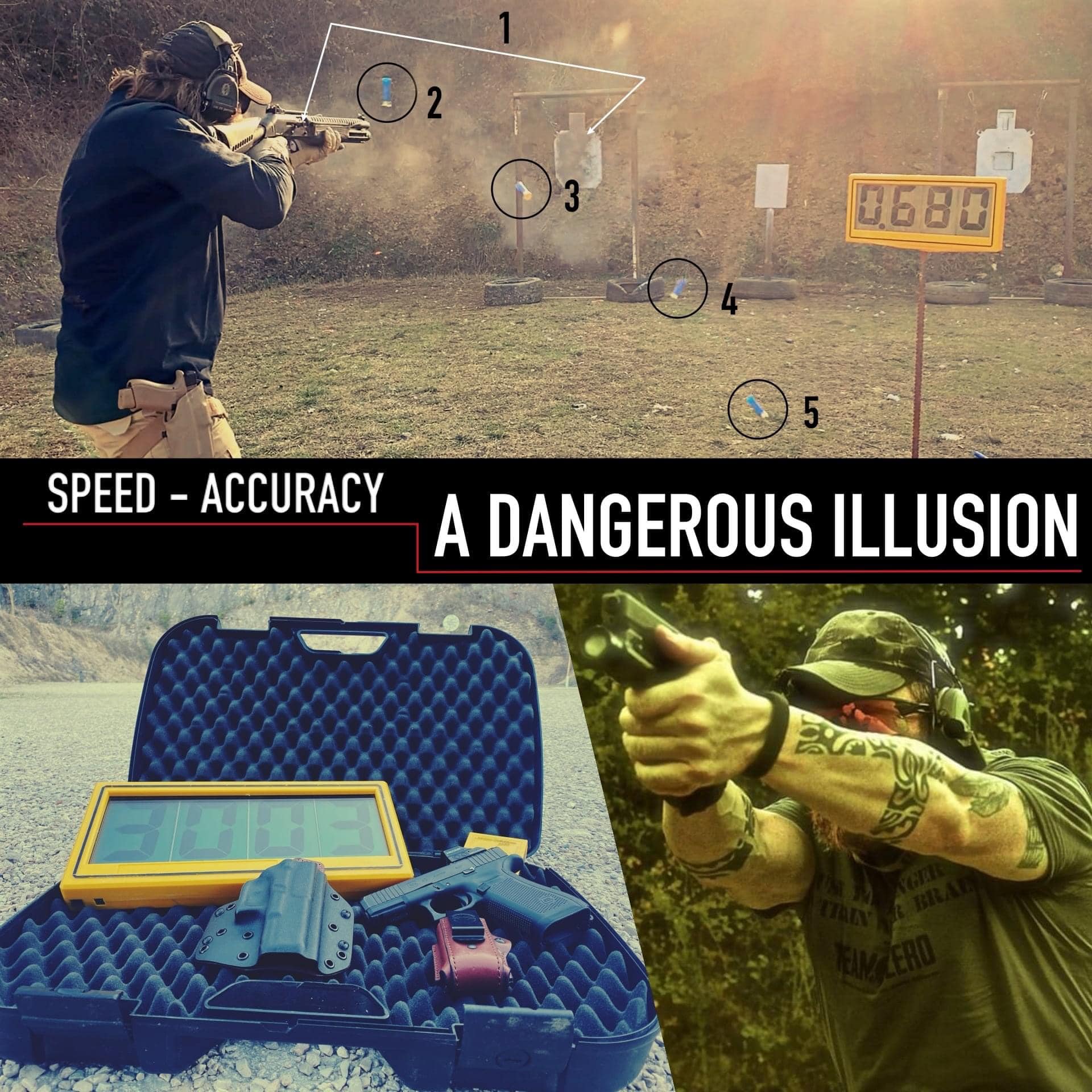There is always a great debate in social media about what is the best way to train and be efficient with a firearm in the defensive field as in competitions. Whenever we talk about efficiency, about training with a firearm, it always ends up in talk about 2 aspects: accuracy and speed.
For years we have been discussing what is more important between accuracy and speed, on which priority is, but in my opinion it is like arguing if the egg comes first than the chicken or the other way around.
Whenever they ask me which is more important between accuracy and speed, I always answer the CONTROL!
Once we have full control of our firearm in STATIC condition, we will work to maximize accuracy, which is nothing more than a perfect synergy Accuracy and speed are in fact both subordinate and essential to the control we have of our firearm, especially when we talk about handgun.
Control is formed by a series of very complex work plans both at a mechanical and biomechanical level and at a cognitive level.
If we do not have a control of the firearm adequate to the technical coefficient of the performance we are about to perform, we will be faced with different scenarios depending on which parameter is prevalent in the performance itself, that is: precision, speed or both.
In case that we have to perform a drill in which precision is the priority technical index and speed is reduced to a minimum to favor the best accuracy on our shooting performance, an inadequate control of the weapon would make us absolutely inaccurate and our performance would therefore still be poor or nil even in the absence of speed.
If, on the other hand, we have to face a technical performance on a drill in which speed is the dominant factor, in which precision can be partially reduced, as in the case of short distances and targets of consistent size (accuracy should never fall below the minimum standard required ), if we do not have a mechanical and cognitive control of our firearm the scenario is completely different.
In this case, in fact, the risk is no longer just that of carrying out a poor performance, but that of losing control of one’s firearm during the performance due to the speed which in this case becomes a parameter of exponential difficulty and therefore consequently an exponential risk, the consequences of which could be disastrous.
So to return to the fateful question “Precision or Speed” I would say that there is a form defect because in reality both are part of an incremental technical process which however starts from an absolute point: the CONTROL.
Of several elements that combine on different work surfaces in a unique way, a bit like an orchestra.
Once I have the control and the accuracy, I will start working on the biomechanical level creating those fundamental sequences that I will have built and assembled according to my needs and my structural characteristics (my body).
When I have created my biomechanical patterns in the total absence of speed, taking care of the absolute perfection and cleanliness of the movement, in every single frame of the sequence, I will begin the long and tiring process of repetitions.
Now, the acquisition of a biomechanical sequence or a cognitive pattern requires an adequate time and number of repetitions but which varies from subject to subject, based on multiple parameters, speaking of standards in terms of time or repetitions is purely empirical and relatively useful.
When my brain has learned to recognize the various mechanical patterns and biomechanical sequences and will process them as a single movement, when my body at a structural level will be able to sustain the cognitive speed with which the order is processed and the sequence is activated, then I can say that I have acquired the “Speed”.
All this, however, I did it starting from the static or semi-dynamic condition, now I have to follow the same process but, this time with an extremely high difficulty index, that is, starting from a DYNAMIC condition.
Having clarified the technical sequence between Precision and Speed, we come to what is the illusion that is often linked to these two fundamental aspects of matter, that is the condition in which we evaluate speed and accuracy and the importance we give to the measurements we obtain, especially by what are nowadays the majority of shooting qualifications.
But we will talk about this in the second part otherwise then you say that I am too verbose…
There is a common say which says : I know my chickens .
“Slow is Smooth Smooth is Fast”
If we want to understand the effective correlation between Speed and Accuracy which will also serve us to identify where and how we must work in training to improve or maximize these two parameters, we must first understand what ACCURACY and SPEED are for us on the perceptual, cognitive and motor plan
At this point gentlemen, however, it is up to you to choose at what level to treat the matter, if you want to do it on a superficial, amateur level by clinging to phrases like “slow is smooth, smooth is fast”, which have a technical index that does not exceed the simple advice based on common sense, then we have already said too much and my work can end here as your reading, because it would be useless to go on.
If, on the other hand, you want to embark on a journey with me in a “world” that is still very little known, however, we will have to go much deeper and arrive at a technical detail that is certainly much more complex but essential to be able to seriously address the subject and be able to begin to UNDERSTAND what we are really talking about.
For years I have been studying and researching methodologies and application schemes for the implementation of the cognitive sphere in the use and application of the firearm.
Because ladies and gentlemen, the key is there, the future will be based on the creation and strengthening of the perceptual and cognitive spheres that will have as a natural collateral the formation and maximization of motor patterns much more evolved and advanced than those of today, as is already happening in many sporting disciplines among the most important.
If only we could work a few hours together, a new world would open up, which is very complex to explain, but working on it you would understand that continuing to carry out training with the firearm based only on the mechanical level using pre-established, limited and fixed motor patterns is a bit like wanting to stay in the Middle Ages.
“Perception> Cognition> Movement”
Over these long years, much of my work has been based on researching which cognitive patterns can be applied to maximize and speed up the essential sequence.
perception> cognition> movement in the field of advanced training with firearms.
We must educate our brain through cognitive patterns to speed up the response to the stimulus, with perceptual patterns we must train the cerebellum to manage and maximize the control of each movement by generating effective immediate compensation responses, we must train the entire system to manage and process instantly enormous amount of flows of sensory information that allows us to adapt and compensate continuously, at the same time we have to train it to program the motor gesture and control its execution to perfection.
“ACCURACY”
Accuracy is therefore the sum, the interaction and the perfect synergy of several work planes, which develop on a perceptive, cognitive and motor / biomechanical level.
Therefore at a perceptual level we will have to build in training schemes that allow us to increase these work planes indispensable for Accuracy, such as the perception of space / distance, the ability to vary the focal plane, the control of spatial and temporal coordinates. , that is the collimation between the perception and the acquisition of the target, on the motor level the biomechanical action with the firearm to align the target.
At the motor level, on the other hand, we will work on fine motor skills such as those relating to the grip, the action of the hand and finger on the trigger and the mechanical manipulation of the firearm and on levels of gross motor skills, such as: positions, posture, center of gravity control, dynamic displacements, adaptation and compensation to environmental conditions.
Although GRIP is the predominant aspect in mechanical control when we are static and the trigger is subordinated to the grip, the more dynamic we become, the greater the importance of the biomechanical sequences of postural compensation and the motor patterns that allow us to be able to maintain mechanical control. of the instrument (firearm) and therefore the accuracy even during the dynamic or unstable phase.
“TIPS”
Minimize the distance, start to build accuracy at 3yds
(work of micro precision) with targets of reduced and progressive sizes, it means to be able to read and isolate also the micro mechanical errors especially coming from the action of the finger / trigger.
So it will be easier to clean, correct, perfect motor patterns and all the rest of the work planes.
Being able to consistently hit targets ranging from a few inches (1 to 2 inches) to a few millimeters (3 to 30) at 3yds, means developing a level of accuracy that allows us to be able to hit larger targets at variable distances, but useful and compatible with the type of firearm we are using.
Building stability through the cognitive-sensory perception of instability. Remember that the greater the perception and the control of stability of the structure (our body) in static and dynamic condition, the greater our compensation capacity and the greater the control of the firearm.
INTRODUCTION TO “SPEED”
When we talk about Speed with firearms regardless of the type of application, the first and most common mistake that is made is to think that there is only one type of speed.
In reality there are two types of speed that we must consider, to simplify and make the concept more understandable we will call them COGNITIVE SPEED and MECHANICAL SPEED, the latter being the one that you usually measure in the shooting range thinking that it is the actual one.
So let’s try to understand what are the main differences between the two speeds.
The first big difference is that the mechanical speed is absolutely subordinate and dependent on the cognitive speed, without a cognitive order that activates the gesture, action, motor sequence, there can be no mechanical speed because there is just no gesture or movement.
The second is that which sees the mechanical speed developing on predefined, pre-known and fixed motor patterns, while the cognitive one develops on perceptive, cognitive and motor patterns created at the moment according to the information processed in that precise moment.
If your cognitive system will not be able to analyze the information flows coming from the sensory sphere and process them instantly by sending the motor orders, you will probably be neutralized with your weapon still in the holster and it will not count if you hit the target in 0.50 when you are at shooting range.
MECHANICAL SPEED (Biomechanical-Motor)
Since it is normally what you measure when you train in the shooting range and that you place as an antagonist or partner of accuracy, let’s try to better understand what it really is and how it works.
Let’s start by saying that the gesture / movement is unique and you will never be able to reproduce another perfectly identical one and that every movement you make even if you repeat it thousands of times will be similar but not identical to the previous ones.
When we build a biomechanical-motor sequence, composed of a series of movements like the “handgun draw”, the main job is to build sequences that have correct and clean gestures / movements and that remain in a range of motor variations as contained as possible. The risk otherwise is that we always going to create different motor patterns in which errors are present and these errors are then memorized and mechanized by thousands of repetitions, therefore later it will be much more difficult to remove them.
At this point, however, we must necessarily define the movement, which is divided into three different types:
REFLEX MOVEMENT: This is ancestral, which does not require cortical and graded modulation by the stimulus. They are generally movements in response to the external environment.
RHYTHMIC MOVEMENT: it is a combination of voluntary and reflex movements. Generally the start is voluntary and the continuation is reflex, such as walking, chewing
VOLUNTARY MOVEMENT: this is certainly the most complex and generated for a specific purpose, unlike the others that are already present in the individual’s motor pattern, this can be learned.
For example, when we talk about handgun draw in extremely compressed times (mechanical speed) or when we talk about magazine changes in very compressed times, they are all voluntary movement sequences but which in a certain sense partly reflect the rhythmic one, because they are activated voluntarily but the continuation is so rapid as to be almost reflected.
The plans of voluntary activity are elaborated by the brain and executive commands are sent to the muscles mainly through the corticospinal system and the corticobulbar system.
The posture is continuously adjusted, not only before, but also during the movement, by posture regulation systems. The movement is made fluid and coordinated by the medial and intermediate portions of the cerebellum (spinocerebellum), with the relative connections.
So the speed with which you perform a motor action, a gesture, a movement is given by the speed of the execution order and the ability of the cerebellum to control the gesture which will be proportional to how many times you have repeated that gesture and how much and how you will have educated your brain to learn that gesture / sequence.
Every time you “make a mistake” drawing your firearm and shooting it is because one or more movements of the sequence have been performed in a different way from the “matrix” movement that was the correct one.
One of the most common mistakes made in training by almost all categories of shooters is to think that to be fast with a firearm you have to make fast movements, that is, that speed depends solely on how quickly that movement, gesture, sequence will be made, and is not taken into consideration at all if instead we are making the minimum number of movements necessary.
Let me explain better, very often sequences are built that have absolutely superfluous and useless movements or structurally wrong and ineffective, these obviously absorb time in the execution phase. The mistake is that instead of maximizing the effectiveness of the movement or sequence, minimizing the number of movements, we try to speed up all of them, even the superfluous and useless ones. In this way the mechanical speed will be based on ineffective motor patterns and forcing the speed will lead to error.



